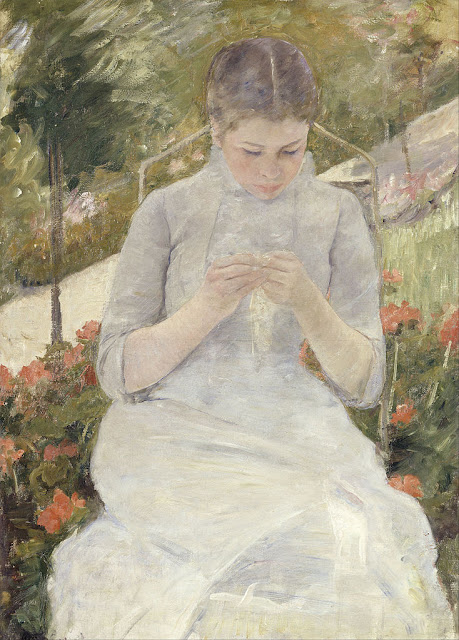 |
| Agnolo Bronzino Holy Family with St Anne and St John the Baptist 1527-28 oil on panel National Gallery of Art, Washington DC |
 |
| Mary Cassatt Under the Horse-Chestnut Tree 1896-97 drypoint, aquatint Museum of Fine Arts, Houston |
 |
| Agnolo Bronzino Panciatichi Holy Family ca. 1540 oil on panel Galleria degli Uffizi, Florence |
 |
| Mary Cassatt Mother about to wash her sleepy child 1880 oil on canvas Los Angeles County Museum of Art |
"But it was Apelles of Cos who surpassed all the painters that preceded and all who were to come after him; he dates in the 112th Olympiad (332-329 BC). He singly contributed almost more to painting than all the other artists put together, also publishing volumes containing the principles of painting. His art was unrivaled for graceful charm, although other very great painters were his contemporaries. Although he admired their works and gave high praise to all of them, he used to say that they lacked the glamour that his work possessed, the quality denoted by the Greek word charis, and that although they had every other merit, in that alone no one was his rival. He also asserted another claim to distinction when he expressed his admiration for the immensely laborious and infinitely meticulous work of Protogenes; for he said that in all respects his achievements and those of Protogenes were on a level, or those of Protogenes were superior, but that in one respect he stood higher, that he knew when to take his hand away from a picture – a noteworthy warning of the frequently evil effects of excessive diligence. The candor of Apelles was however equal to his artistic skill: he used to acknowledge his inferiority to Melanthius in grouping, and to Asclepiodorus in nicety of measurement, that is in the proper space to be left between one object and another."
 |
| Agnolo Bronzino Holy Family with St Anne and St John the Baptist 1540-42 oil on panel Louvre, Paris |
 |
| Agnolo Bronzino Holy Family with St Anne and St John the Baptist ca. 1545-46 oil on panel Kunsthistorisches Museum, Vienna |
 |
| Mary Cassatt Woman sitting with child in her arms ca. 1890 oil on canvas Museo de Bellas Artes de Bilbao |
 |
| Mary Cassatt Girl in the garden ca. 1880-82 oil on canvas Musée d'Orsay, Paris |
"Moreover, it was a regular custom with Apelles never to let a day of business to be so fully occupied that he did not practice his art by drawing a line, which has passed from him into a proverb. Another habit of his was when he had finished his works to place them in a gallery in the view of passers by, and he himself stood out of sight behind the picture and listened to hear what faults were noticed, rating the public as a more observant critic than himself. And it is said that he was found fault with by a shoemaker because in drawing a subject's sandals he had represented the loops in them as one too few, and the next day the same critic was so proud of the artist's correcting the fault indicated by his previous objection that he found fault with the leg, but Apelles indignantly looked out from behind the picture and rebuked him, saying that a shoemaker in his criticism must not go beyond the sandal – a remark that has also passed into a proverb. In fact he was possessed of great courtesy, which made him more agreeable to Alexander the Great, who frequently visited his studio – for, as we have said, Alexander had published an edict forbidding any other artist to paint his portrait; but in the studio Alexander used to talk a great deal about painting without any real knowledge of it, and Apelles would politely advise him to drop the subject, saying that the boys engaged in grinding the colors were laughing at him: so much power did his authority exercise over a king who was otherwise of an irascible temper."
– this passage and the one above from the Natural History of Pliny the Elder (AD 23-79), translated during the 1930s for the Loeb Classical Library by H. Rackham
 |
| Agnolo Bronzino Crossing of the Red Sea (detail) from the Chapel of Eleonora of Toledo 1540-45 fresco Palazzo Vecchio, Florence |
 |
| Mary Cassatt Woman with pearl necklace in a loge 1879 oil on canvas Philadelphia Museum of Art |
 |
| Agnolo Bronzino The Falling of the Manna (detail) from the Chapel of Eleonora of Toledo 1540-45 fresco Palazzo Vecchio, Florence |
 |
| Mary Cassatt In the Loge 1878 oil on canvas Museum of Fine Arts, Boston |
 |
| Agnolo Bronzino Adoration of the Bronze Snake (detail) from the Chapel of Eleonora of Toledo 1540-45 fresco Palazzo Vecchio, Florence |
 |
| Mary Cassatt The Boating Party 1893-94 oil on canvas National Gallery of Art, Washington DC |